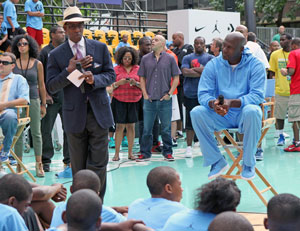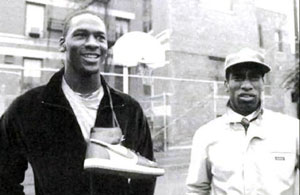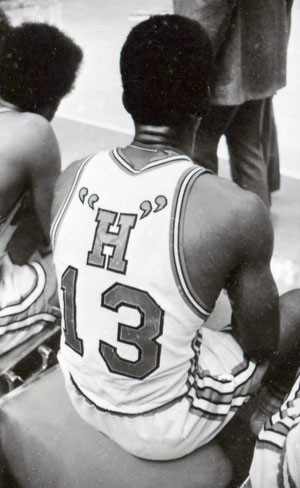- April 22, 2014
- By Liam Farrell
Michael Jordan’s basketball career is memorialized in a simple image: a silhouette of the lithe athlete in the air, a ball in his hand and legs akimbo on the way to dunking into an unseen hoop.
Jordan was—is—Nike’s “Jumpman” logo, and the logo is Jordan. For 30 years, that rare mix has convinced fans to buy sneakers, shorts and shirts in the hopes that one day they could play like him.
It all may have turned out differently if a Terp hadn’t been there when Jordan first signed a deal with Nike that would revolutionize sports marketing and apparel.

His name is Howard White ’73, a vice president of marketing at Nike’s Jordan Brand, but he’s better known as “H,” the initial that Coach Lefty Driesell let the Hampton, Va., native wear on the back of his jersey while playing point guard for the Terps.
“Whatever college I was going to,” he says, “I was going to be the ‘Big H.’”
It was an homage to basketball star Oscar Robertson, nicknamed the “Big O,” and a reference to who White’s high school coach believed he had the skills to emulate. That was the beginning of a lifetime of White trying to tap into his own dreams and give others the confidence to do the same.
“Maybe the grandest thing in the world is dreaming,” he says. “That dream that high school coach put in my mind was, you can be something or somebody.”
Heavily recruited before college, White found that same sense of possibility standing in Cole Field House.
“You just imagine, ‘Wow, a lot of things could happen here,’” he says.
At Maryland, White was part of a team that won the National Invitation Tournament in 1972 and made a regional final in the 1973 NCAA Tournament. Although drafted into the NBA, a long line of knee injuries finally ended his playing career.

“If his knees had never been hurt, he would have been an All-American. He was a heck of a player,” Driesell says. “Howard was a leader. He was very intelligent, he knew the game.”
Basketball stayed a big part of White’s life, and he became an assistant coach for Driesell. One of his biggest tasks was to recruit a fellow Virginian, Moses Malone (“Big Mo, that’s my guy,” White says today) to come to Maryland. Malone planned to be a Terp until he was drafted into the American Basketball Association, becoming one of the first high school players to jump straight into the pros.
White (and Maryland) missed on that future Hall of Famer, but it was an introduction for him into the type of treatment and relationships that athletes value. It built on an even earlier lesson from his mother, who had scolded the 10-year-old White when he passed a neighbor one day without saying hello, preferring to wing rocks at a stop sign instead.
“Even a dog can wag his tail when he walks past you on the street,” his mother said—a lesson, he acknowledges, which “just happened to pay dividends.”
Many of those dividends started accumulating when Michael Jordan, turning pro out of North Carolina and wanting to sign with Adidas, was dragged by his parents to a 1984 meeting in Oregon with Nike executives. White, who in 1978 had started as a Nike field representative, was part of the team tasked with convincing Jordan to join the up-and-coming firm instead.
What sticks out in White’s mind today is the desire Jordan’s parents had for a family atmosphere. They wanted to know someone would look after his best interests, and White says the budding superstar eventually “became like a younger brother.”
“We traveled the world together, confided in each other, helped each other dream,” he says. “I hope I could have played that small part to help them see (a Nike partnership) could be something.”

It didn’t take long. In October 1984, Nike got an early boost when the NBA banned Jordan’s sneakers for nonconformity, leading to a memorable ad campaign about how “the NBA can’t keep you from wearing them.” Within two months of hitting shelves the next year, Air Jordan Is had brought in $70 million for Nike, at $65 a pair, according to ESPN.
Jordan biographer David Halberstam wrote in “Playing for Keeps” that White stayed close to Jordan “to help guide him through the predatory world that surrounds the NBA, a world filled with people willing to exploit the fame of the players.”
“It was a shrewd move on Nike’s part, out of which a true friendship blossomed,” Halberstam wrote. “The older, wiser White helped steer Jordan though the potentially difficult first season and helped him to avoid many of the pitfalls that await most rookies.”
Jordan went on to become an unmatched global sports figure that still resonates today. Though he’s been retired since 2003, Forbes noted in February that Jordan’s brand had $2.25 billion in U.S. sales in 2013, and makes up one of every two basketball shoes sold in the country. With White’s help as the brand’s primary mentor and liaison to athletes, a whole new generation of players, in not only basketball but also baseball, football, boxing and track, wear apparel emblazoned with that ever-floating Jumpman.
“Michael was hope for so many people. There is a gold standard and it’s hard work and dedication to reach that,” White says. “He showed people what it is to overcome obstacles. Those things make people believe.”
And White has made many others believe as well. In his time at Nike, he has shepherded athletes like Charles Barkley and Deion Sanders, who once told The Baltimore Sun that White “is the glue that keeps the players with Nike.”
“If he had stayed coaching, he would probably be a head coach at a big-time school,” Driesell says. “I think Howard would have done well in whatever he did.”
A seminal moment for White came when he asked Phil Knight, Nike’s co-founder and chairman, how far he could go at the company. Knight said, “If you want to, you can get all the way to this seat.”
White, who went on to start Nike’s “Believe to Achieve” program for empowering youth, never guarantees that the athletes or children he talks to will become the next Michael Jordan or Nike executive. Instead, he wants them to know the power that comes from taking Knight’s quote to heart and believing that living one’s dream—say, a kid from Virginia eventually becoming part of one of the most powerful cultural forces in American history—is actually possible.
“I’ve tried to lead others down that path,” he says.
Terp would like to thank the staff at University Archives and “Terrapin Tales,” the archives’ blog, for first reporting this story. For more on Howard White and many other great Maryland stories, visit umdarchives.wordpress.com.
